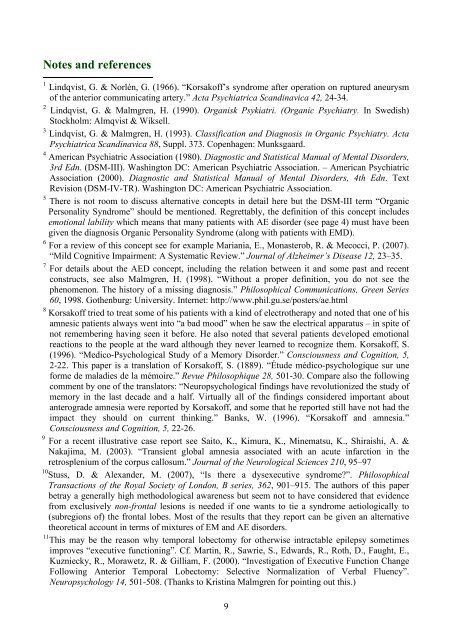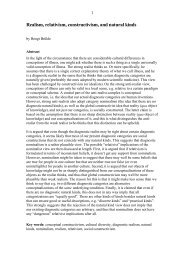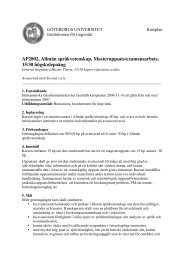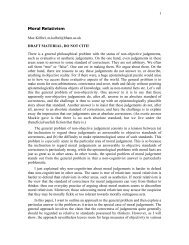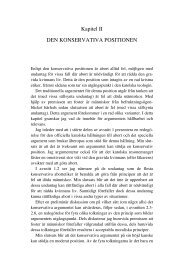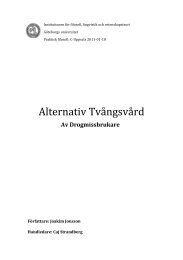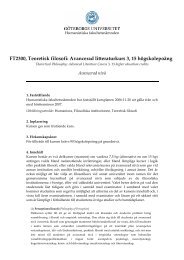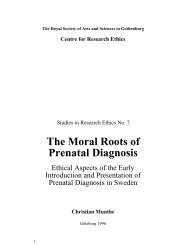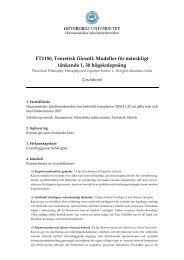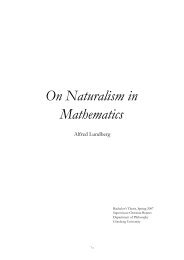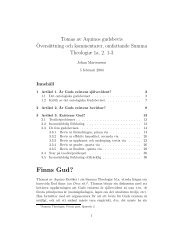Memory, emotion and brain injury Memory, emotion and brain injury
Memory, emotion and brain injury Memory, emotion and brain injury
Memory, emotion and brain injury Memory, emotion and brain injury
Create successful ePaper yourself
Turn your PDF publications into a flip-book with our unique Google optimized e-Paper software.
Notes <strong>and</strong> references<br />
1 Lindqvist, G. & Norlén, G. (1966). “Korsakoff’s syndrome after operation on ruptured aneurysm<br />
of the anterior communicating artery.” Acta Psychiatrica Sc<strong>and</strong>inavica 42, 24-34.<br />
2 Lindqvist, G. & Malmgren, H. (1990). Organisk Psykiatri. (Organic Psychiatry. In Swedish)<br />
Stockholm: Almqvist & Wiksell.<br />
3 Lindqvist, G. & Malmgren, H. (1993). Classification <strong>and</strong> Diagnosis in Organic Psychiatry. Acta<br />
Psychiatrica Sc<strong>and</strong>inavica 88, Suppl. 373. Copenhagen: Munksgaard.<br />
4 American Psychiatric Association (1980). Diagnostic <strong>and</strong> Statistical Manual of Mental Disorders,<br />
3rd Edn. (DSM-III). Washington DC: American Psychiatric Association. – American Psychiatric<br />
Association (2000). Diagnostic <strong>and</strong> Statistical Manual of Mental Disorders, 4th Edn. Text<br />
Revision (DSM-IV-TR). Washington DC: American Psychiatric Association.<br />
5 There is not room to discuss alternative concepts in detail here but the DSM-III term “Organic<br />
Personality Syndrome” should be mentioned. Regrettably, the definition of this concept includes<br />
<strong>emotion</strong>al lability which means that many patients with AE disorder (see page 4) must have been<br />
given the diagnosis Organic Personality Syndrome (along with patients with EMD).<br />
6 For a review of this concept see for example Mariania, E., Monasterob, R. & Mecocci, P. (2007).<br />
“Mild Cognitive Impairment: A Systematic Review.” Journal of Alzheimer’s Disease 12, 23–35.<br />
7 For details about the AED concept, including the relation between it <strong>and</strong> some past <strong>and</strong> recent<br />
constructs, see also Malmgren, H. (1998). “Without a proper definition, you do not see the<br />
phenomenon. The history of a missing diagnosis.” Philosophical Communications, Green Series<br />
60, 1998. Gothenburg: University. Internet: http://www.phil.gu.se/posters/ae.html<br />
8 Korsakoff tried to treat some of his patients with a kind of electrotherapy <strong>and</strong> noted that one of his<br />
amnesic patients always went into “a bad mood” when he saw the electrical apparatus – in spite of<br />
not remembering having seen it before. He also noted that several patients developed <strong>emotion</strong>al<br />
reactions to the people at the ward although they never learned to recognize them. Korsakoff, S.<br />
(1996). “Medico-Psychological Study of a <strong>Memory</strong> Disorder.” Consciousness <strong>and</strong> Cognition, 5,<br />
2-22. This paper is a translation of Korsakoff, S. (1889). “Étude médico-psychologique sur une<br />
forme de maladies de la mémoire.” Revue Philosophique 28, 501-30. Compare also the following<br />
comment by one of the translators: “Neuropsychological findings have revolutionized the study of<br />
memory in the last decade <strong>and</strong> a half. Virtually all of the findings considered important about<br />
anterograde amnesia were reported by Korsakoff, <strong>and</strong> some that he reported still have not had the<br />
impact they should on current thinking.” Banks, W. (1996). “Korsakoff <strong>and</strong> amnesia.”<br />
Consciousness <strong>and</strong> Cognition, 5, 22-26.<br />
9 For a recent illustrative case report see Saito, K., Kimura, K., Minematsu, K., Shiraishi, A. &<br />
Nakajima, M. (2003). “Transient global amnesia associated with an acute infarction in the<br />
retrosplenium of the corpus callosum.” Journal of the Neurological Sciences 210, 95–97<br />
10 Stuss, D. & Alex<strong>and</strong>er, M. (2007), “Is there a dysexecutive syndrome”. Philosophical<br />
Transactions of the Royal Society of London, B series, 362, 901–915. The authors of this paper<br />
betray a generally high methodological awareness but seem not to have considered that evidence<br />
from exclusively non-frontal lesions is needed if one wants to tie a syndrome aetiologically to<br />
(subregions of) the frontal lobes. Most of the results that they report can be given an alternative<br />
theoretical account in terms of mixtures of EM <strong>and</strong> AE disorders.<br />
11 This may be the reason why temporal lobectomy for otherwise intractable epilepsy sometimes<br />
improves “executive functioning”. Cf. Martin, R., Sawrie, S., Edwards, R., Roth, D., Faught, E.,<br />
Kuzniecky, R., Morawetz, R. & Gilliam, F. (2000). “Investigation of Executive Function Change<br />
Following Anterior Temporal Lobectomy: Selective Normalization of Verbal Fluency”.<br />
Neuropsychology 14, 501-508. (Thanks to Kristina Malmgren for pointing out this.)<br />
9


